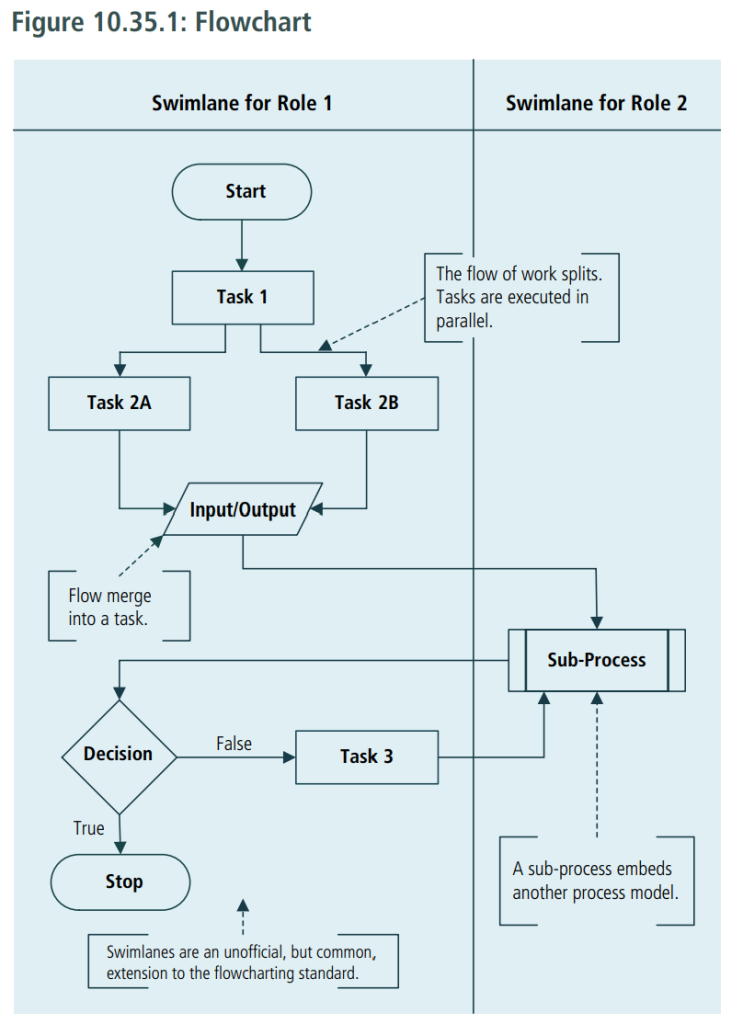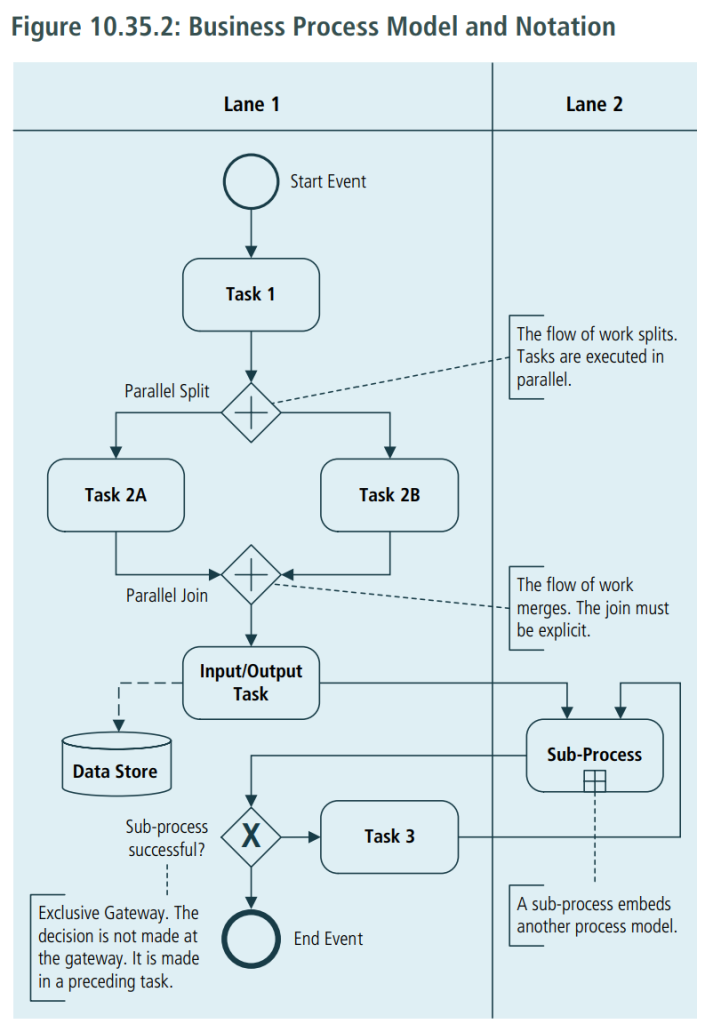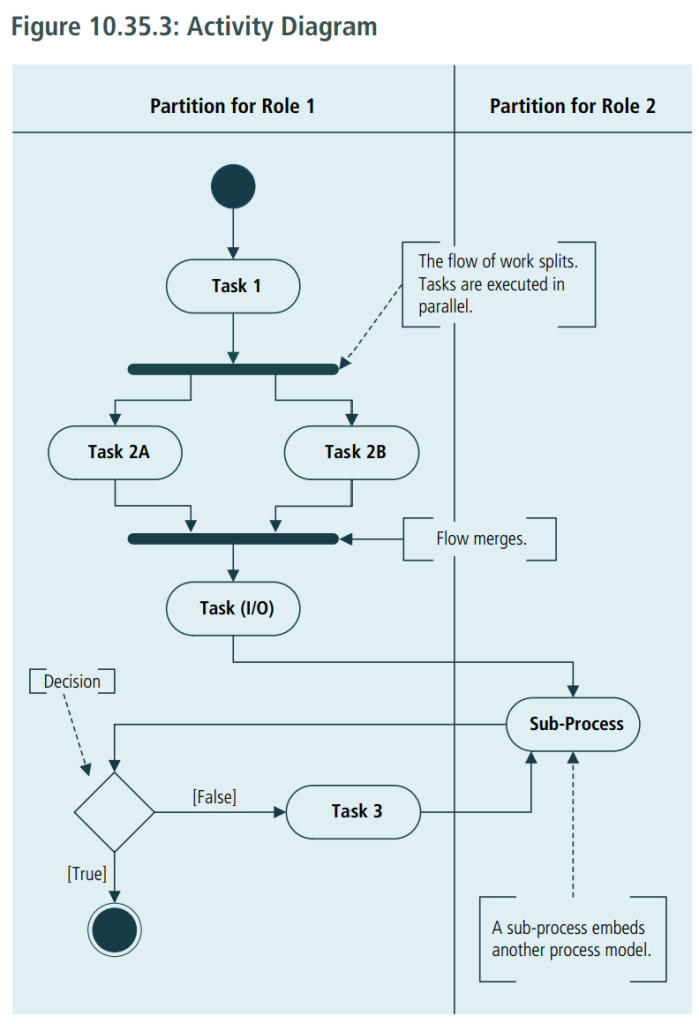10.35.1 Purpose
Process modelling is a standardized graphical model used to show how work is carried out and is a foundation for process analysis.
10.35.2 Description
Process models describe the sequential flow of work or activities. A business process model describes the sequential flow of work across defined tasks and activities through an enterprise or part of an enterprise. A system process model defines the sequential flow of control among programs or units within a computer system. A program process flow shows the sequential execution of program statements within a software program. A process model can also be used in documenting operational procedures.
A process model can be constructed on multiple levels, each of which can be aligned to different stakeholder points of view. These levels exist to progressively decompose a complex process into component processes, with each level providing increasing detail and precision. At a high (enterprise or context) level, the model provides a general understanding of a process and its relationship to other processes. At lower (operational) levels, it can define more granular activities and identify all outcomes, including exceptions and alternative paths. At the lowest (system) level, the model can be used as a basis for simulation or execution.
Process models can be used to:
- describe the context of the solution or part of the solution,
- describe what actually happens, or is desired to happen, during a process,
- provide an understandable description of a sequence of activities to an external observer,
- provide a visual to accompany a text description, and
- provide a basis for process analysis.
The business analyst can use a process model to define the current state of a process (also known as an as-is model) or a potential future state (also known as a to-be model). A model of the current state can provide understanding and agreement as to what happens now. A model of the future state can provide alignment with what is desired to happen in the future.
Process models generally include:
- the participants in the process,
- the business event that triggers the process,
- the steps or activities of the process (both manual and automated),
- the paths (flows) and decision points that logically link those activities, and
- the results of the process.
The most basic process model includes: a trigger event, a sequence of activities, and a result.
A more comprehensive process model can include other elements, such as data/materials, inputs and outputs, and call-out descriptions that supplement the graphical representation.
10.35.3 Elements
.1 Types of Process Models and Notations
Many different notations are used in process modelling.
The most commonly used notations include the following:
- Flowcharts and Value Stream Mapping (VSM): used in the business domain.
- Data Flow diagrams and Unified Modelling Language™ (UML®) diagrams: used in the information technology domain.
- Business Process Model and Notation (BPMN): used across both business and information technology domains; is increasingly adopted as an industry standard.
- Integrated DEFinition (IDEF) notation and Input, Guide, Output, Enabler (IGOE) diagrams: used for establishing scope.
- SIPOC and Value Stream Analysis: used for process modelling.
Process models typically contain some or all of the following key elements:
- Activity: an individual step or piece of work that forms part of the business process. It may be a single task or may be further decomposed into a subprocess (with its own activities, flow, and other process elements).
- Event: a zero-time occurrence which initiates, interrupts, or terminates an activity or task within a process or the process itself. It may be a message received, the passage of time, or the occurrence of a condition as defined in the business rules.
- Directional Flow: a path that indicates the logical sequence of the workflow. In general, diagrams are drawn to show the passage of time in a consistent fashion (typically in the direction that text would be read).
- Decision Point: a point in the process where the flow of work splits into two or more flows (paths), which may be mutually exclusive alternatives or parallels. A decision can also be used to locate rules where separate flows merge together.
- Link: a connection to other process maps.
- Role: a type of person or group involved in the process. Its definitions typically match those in the organizational model.
Flowchart
Flowcharts are used commonly with non-technical audiences and are good for gaining both alignment with what the process is and context for a solution. A flowchart can be simple, displaying just the sequence of activities, or it can be more comprehensive, using swimlanes. A swimlane is a partitioned area (horizontal or vertical) that segregates those activities in the process that are carried out by a particular role.

Business Process Model and Notation (BPMN)
Business Process Model and Notation (BPMN) provides an industry-standard language for modelling business processes in a form that is accessible by both business users and technical developers. BPMN is designed to cover many types of modelling, including both internal (private) processes and collaborative (public) processes. It can be the input to process automation technologies.
A key feature of BPMN is its ability to distinguish the activities of different participants in a process with pools and swimlanes. When the flow of work crosses the boundary of a swimlane, responsibility for the work then passes to another role within the organization. Swimlanes are part of a pool. A pool is a self-regulating (free-standing) business entity, typically an organization or a system. A pool may include a number of swimlanes, each of which represents a role. Commonly, a process includes one pool for the customer and a second pool for the organization under study, although it is possible for a process to include any number of pools.

Activity Diagram
The activity diagram is one of the use case realization diagrams defined in the Unified Modelling Language™ (UML®). Originally designed to elaborate on a single use case, the activity diagram has been adopted for more general process modelling purposes, including business process modelling. While similar in appearance to a flowchart, the activity diagram typically employs swimlanes to show responsibilities, synchronization bars to show parallel processing, and multiple exit decision points.

10.35.4 Usage Considerations
.1 Strengths
- Appeals to the basic human understanding of sequential activities.
- Most stakeholders are comfortable with the concepts and basic elements of a process model.
- The use of levels can accommodate the different perspectives of various stakeholder groups.
- Effective at showing how to handle a large number of scenarios and parallel branches.
- Can help identify any stakeholder groups that may have otherwise been overlooked.
- Facilitates the identification of potential improvements by highlighting “pain points” in the process structure (i.e. process visualization).
- Likely to have value in its own right. They provide documentation for compliance purposes and can be used by business stakeholders for training and coordination of activities.
- Can be used as a baseline for continuous improvement.
- Ensures labelling consistency across artifacts.
- Provides transparency and clarity to process owners and participants on activity responsibilities, sequence and hand-overs.
.2 Limitations
- To many people in IT, a formal process model tends to reflect an older and more document-heavy approach to software development. Therefore, project time is not allocated to developing a process model, especially of the current state or problem domain.
- Can become extremely complex and unwieldy if not structured carefully. This is especially true if business rules and decisions are not managed separately from the process.
- Complex processes can involve many activities and roles; this can make them almost impossible for a single individual to understand and ‘sign off’.
- Problems in a process cannot always be identified by looking at a high-level model. A more detailed model with reference to metadata (such as path frequency, cost, and time factors) is usually required. It is often necessary to engage with stakeholders directly to find the operational problems they have encountered while working with a process.
- In a highly dynamic environment where things change quickly, process models can become obsolete.
- May prove difficult to maintain if the process model only serves as documentation, as stakeholders may alter the process to meet their needs without updating the model.
